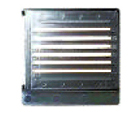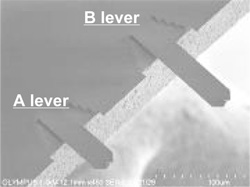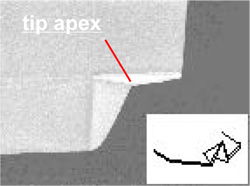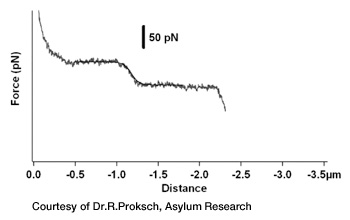BioLever Discontinued
BL-RC150VB-HW / 210 chips, Both side gold coating
BL-RC150VB-C1 / 24 chips, Both side gold coating
for Force curve measurement of Bio samples
Characteristics
- Two types of cantilevers suitable for force curve measurements of bio samples.
A lever (60µm long) : Low noise cantilever
B lever (100µm long) : Small spring constant cantilever - Gold on both sides of cantilever
Gold coating on the tip side makes functionalizing the tip easier (e.g., using thiol chemistry) - The tip is located at the very end of the cantilever.
Since the tip isn't hidden by the body of cantilever, it can be positioned exactly at a point of interest using an optical microscopy. - Sharp and tall V-shaped tip
The radius of curvature of the tip is 40nm or less (30 nm typ.). The tip height is more than 5µm high to help preventing the body of the cantilever from touching a specimen. - Two choices of product units, Small quantity unit and Half wafer unit.
Pre-separated chips offered in Gel-Pak case (Small quantity unit 24 chips/unit )
A half wafer unit contains 6 strips of chip arrays ,or 210 chips per unit.


Cantilever
The rectangular silicon nitride cantilevers with both-side gold coating show the mechanical properties below. A lever is the shortest and B lever is the softest cantilever commercially available (as of Aug. 2001).

| A lever | B lever | |
|---|---|---|
| Length x width | 60µm x 30µm | 100µm x 30µm |
| Thickness | 180nm (incl. gold coating) | |
| Resonant Freq | 37 kHz | 13 kHz |
| Spring const. | 30 pN/nm (0.03 N/m) |
6 pN/nm (0.006 N/m) |
Lever and tip material Silicon nitride
Thickness of gold coating tip side 20 nm Reflex 30 nm
Tip
SEM micrograph around the tip observed from the tip side

The OLYMPUS V-shaped tip is stably shapened even with the 7um- height tip (typ.). The V-shaped tip is unique. Geometrically, it is a hollow pyramid sliced in half vertically with a sharpened apex.
| tip height | > 5µm, 7µm(typ.) |
|---|---|
| tip radius | < 40nm, 30nm(typ) |
| tip angle | < 45 deg. (side) < 90 deg. (front) |

What type of the cantilever is suitable for force curve measurements ?
To generate force curve in scanning probe microscopy, the cantilever probe is to go up and down against the sample as illustrated below. You can get the information of the sample as hardness, adhesiveness and folding force of the protein molecule etc. by monitoring the caniltever deflection.

Soft cantilever (small spring constant) is requested to measure a weak force act in soft samples as bio samples. OLYMPUS achieves the small spring constant less than 10pN/nm with B lever of the Bio-Lever.

The left chart is the thermal vibration spectrum of the B lever at room temperature. The resonant frequency is 12 kHz and the spring constant is estimated at 3pN/nm by thermal method.
In force curve measurements, thermal noise of the cantilever itself should be small. As Brawnian motion of particles in water, that is well known phenomina , the cantilever vibrates thermally. This is a mechanical noise which worsens the S/N ratio of the force measurement.
Short cantilever is the solution for lowering the noise level. When the spring constant is the same, the shorter cantilever shows less thermall noise in the band width of the SPM instrument.
The A lever of the OLYMPUS Bio-Lever (60µm long) is the shortest cantilever avairable in the market and shows the spring constant of 30pN/nm (typ.).
As a practical application of lower noise measurements to single molecule force measurements, graph ( right ) shows a measurement of the B-S transition in lambda digest DNA in PBS solution. The noise level is obviously lower than the step in the middle of the curve of around 55pN.

